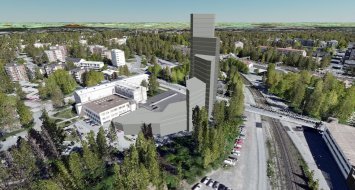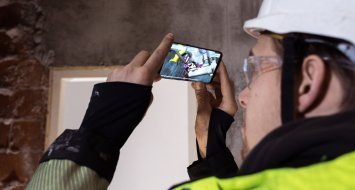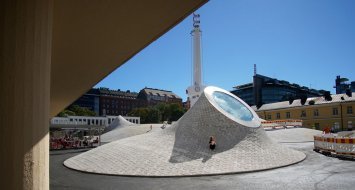Internet of Things sensors and IoT-capable devices provide a huge amount of data from buildings. To make this data useful and usable for research, Aalto University is developing and testing a service that links IoT with building information models, BIMs.
“The idea to start an experiment on linking IoT with BIM at the Otaniemi campus originated from discussions we had within professor Martti Mäntylä’s Aalto campus IoT group. We realized that several small research projects were simultaneously testing IoT here. So we decided to create a framework for sharing information between the projects,” says Seppo Törmä, CEO of VisuaLynk.
Building a Digital Campus
KIRA-digi, the Finnish government’s spearhead digitalization project, offered funding for experimenting with the idea. The university’s IT unit, Aalto IT, contracted with VisuaLynk, which agreed to provide the required software during the experiment.
VisuaLynk is a software-as-a-service that collects, connects, and presents visual data from IoT devices and BIMs. It is also capable of analyzing building information with AI and machine learning algorithms.
The goal of Aalto IT is to become a “digital campus” of Otaniemi. They want to enable the information flow across organizations and systems in the campus. For example, they are implementing capabilities that grant users access to several in-house and external systems, like VisuaLynk, through a single sign-on.
Making Building Information Usable
The experiment started at the beginning of 2018 and will conclude at the end of the year. The project will showcase a user interface with BIMs and related IoT sensor data to be used for property and facilities management. The team plans to include two models of old buildings, all the models of recently erected buildings, and a model of Dipoli, the iconic exhibition and conference center.
Vishal Singh is an assistant professor at Aalto and R&D manager of VisuaLynk. He sees the project as an opener: “At this phase, this is a proof-of-concept. The first objective toward the digital campus is to show that aggregating data this way is possible and that the interface provides information in a meaningful way. That will pull in people who are doing development work. Taking this to a wider community will naturally require iterations and refinement.”
VisuaLynk claims to be one of the leaders in the utilization of building data. A large portion of the data is usually lost after the construction phase. VisuaLynk keeps it alive in a visual and easy to customize environment and links it with data from other sources. The data retrieved from IoT sensors include information on temperature, humidity, CO2, and pressure differences. Some sensors will possibly send out occupancy data.
“Most applications offer more or less a predefined set of functionalities. The strength of VisuaLynk is that it’s a flexible platform, which serves the changing needs of the industry perfectly,” says Mehmet Yalcinkaya, the lead developer.
Bringing BIMs into Facilities Management and Use Is Not Easy
The VisuaLynk team has faced two major challenges in this project: technical and organizational. The technical complexity of integration is manageable. The lack of rules and responsibilities in the provision and exchange of data is a bigger problem. Every case seems to be different, which makes it hard to systematize data aggregation.
The contents of the BIMs are sometimes confusing. In construction projects, no one seems to have control over what data is included in the models and how it is presented. Designers export IFC files from their BIM systems and pass them on to others without a second thought. In general, the models contain too much irrelevant information or almost no relevant information for the building owner and users.
Törmä thinks that, instead of trying to create perfect BIMs of existing buildings, their models can be annotated afterward, a process that could be crowdsourced. Törmä envisions how freshman students could gather and store data on the campus as a first-year orientation task.
Standards Don’t Support Typical User Needs
The KIRA-digi experiment uses the IFC as a standard data exchange format, but it’s not the optimal solution. Törmä points out that IFC has been specified “too loosely,” and therefore you cannot know exactly what you are getting when you exchange IFC data.
Furthermore, the IFC and the apps that use it are based on the assumption that whole building models are transferred every time. That does not play well when you need to exchange data in smaller portions.
Typically, users need information on a micro-level, for example of a room or a certain piece of hardware. In most cases, the whole model must still be loaded first in order to obtain that piece of information.
Törmä believes that the use of ontologies, conceptual models of objects and their relations, could mitigate this problem. There can be several ontologies on the same data. Companies and institutions can develop their own extensions to the basic ontology. The creator and the receiver of a model know exactly how the data fits into their own process. This approach also works well for piecemeal data exchange.
What’s Next?
The VisuaLynk team is optimistic that their solution could be scaled up for other institutional clients, like hospitals. However, large clients have complex environments, which calls for domain knowledge and provision of consulting services during the implementation phase.
“In the KIRA-digi project, we’ve tried to bring some of the parties together. That, hopefully, will trigger long-term collaboration for aggregating building information,” says Singh. “For somebody who wants to coordinate information management as a supervisor or a control room operator, this is a great platform. It could develop into an ecosystem for all sorts of app developers that want to use aggregated building data.”
Other news

The Winning Teams at the AEC Hackathon Helsinki
The AEC Hackathon on September 7-9, 2018, was a part of Housing Fair Finland’s City Living...

City Development with Interactive 3D Models
The Finnish city of Hyvinkää has developed a unique internet service for collaborative 3D ...

BIM Meets Reality on the Construction Site
BIM models are mostly used by foremen on construction sites. But what if they could be mad...

How BIM Can Serve Building Owners
Building Information Models typically end their active life after the construction phase. ...

